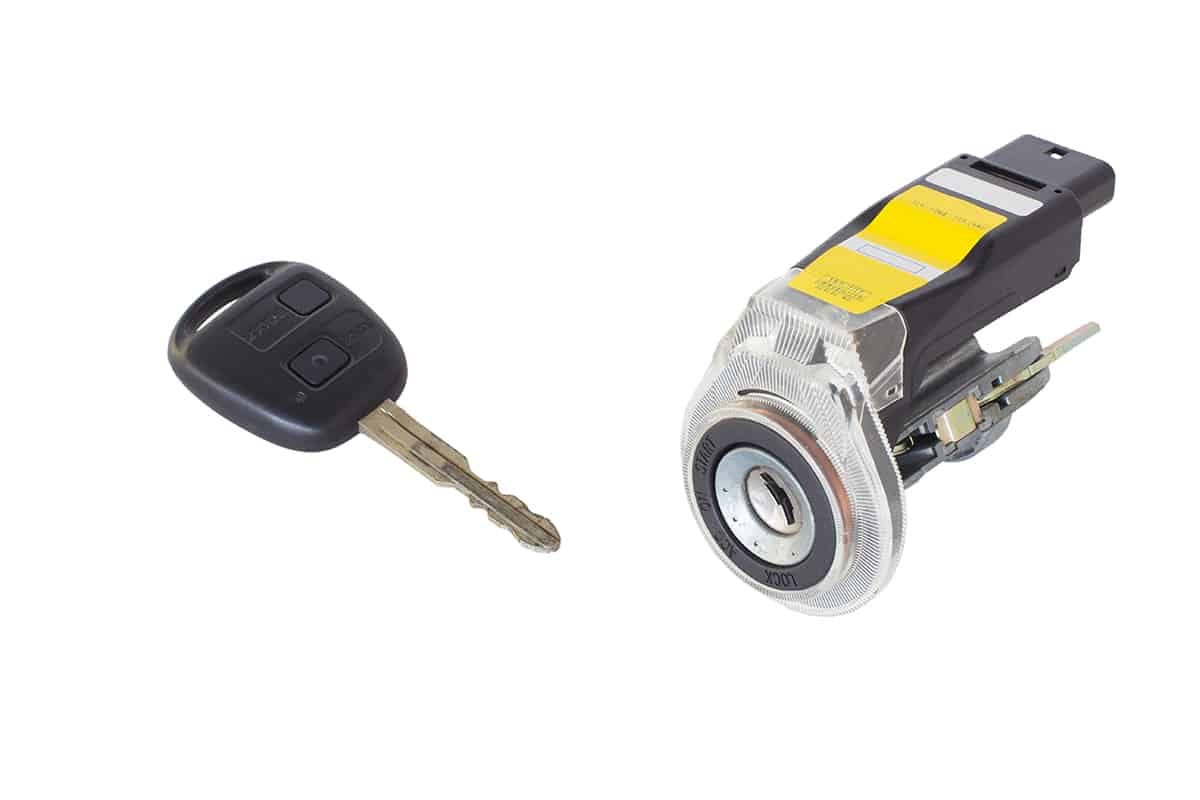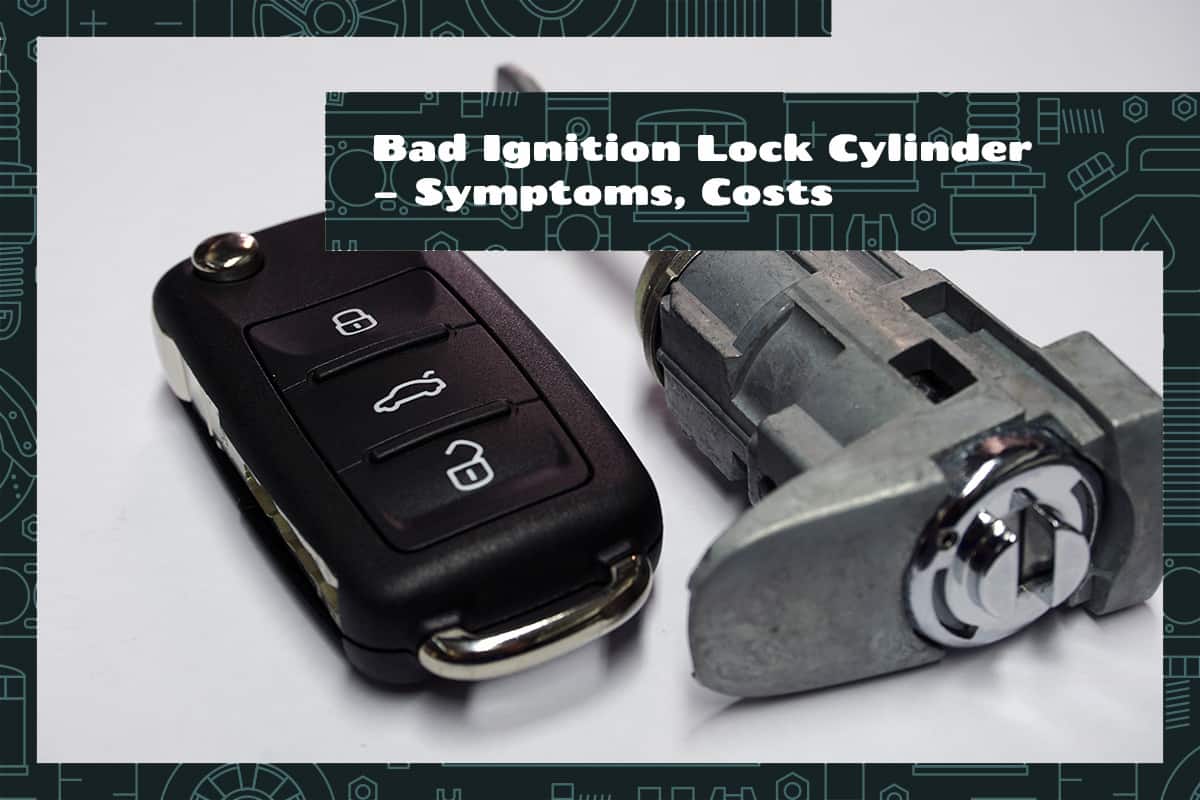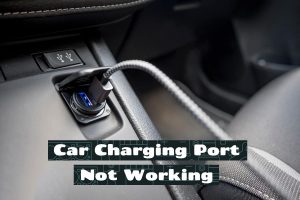When you insert and turn the key, the ignition lock cylinder sends a signal to start the engine, and off you go! If it isn’t working right, your car won’t work either. It’s a vital part that needs to be in top shape for your vehicle to operate smoothly.
If your ignition lock cylinder is faulty, it may show the following signs:
- Trouble turning the key
- Trouble starting the engine
- Stalling or power loss
- Not be able to insert or remove the key properly
Repairing or replacing a bad ignition lock cylinder can cost as little as $200 or as high as $500, including parts and labor.
In this article, we’ll delve into the details of the ignition lock cylinder, understand its common issues, the costs involved in replacing it, and much more.
Taking a Closer Look at the Ignition Cylinder Lock
The ignition lock cylinder is a simple yet highly important part when starting your car. It is a small, cylindrical part where you insert your car key. Think of it as a door. It opens when you insert the right key, letting your car know you are the authorized driver. But instead of opening a physical door, this ‘door’ allows electricity to flow to the engine, kick-starting your car into life.
It plays a crucial role in your car’s anti-theft system too. The key for each ignition lock cylinder has a unique pattern. Unless the pattern on the key matches with the pattern inside the cylinder, your car will not start. So, if someone tries to start your car with the wrong key, the car won’t start.
Key Ignition Lock Cylinder Components

The ignition lock cylinder has a few key parts that help start your car and keep it secure. Let’s explore these components.
1. Key insert and rotary switch
You’re already familiar with the key insert, where you put your key. Inside this, small pieces called tumblers match your key’s shape. When you turn the key, these tumblers move, activating the rotary switch. This switch has different positions, each sending a unique instruction to your car.
2. Electrical switching mechanism
This is the heart of the ignition lock cylinder. After turning the key, the electrical switching mechanism sends power to different parts of your car. For instance, in one position, it might power the radio and lights. In another, it can trigger the ignition system, starting the engine.
3. Transponder chip and security features
Most modern keys have a transponder chip. This chip sends a unique signal to your car’s computer when you insert and turn the key. If the signal matches what the car expects, the car will start. If not, the car remains off.
Common Symptoms of a Bad Ignition Lock Cylinder
If the ignition lock cylinder is faulty, your car might act differently. Here are some signs that something might be wrong with the ignition lock cylinder.
1. Difficulty turning the key
This could be due to wear and tear of the key or the lock cylinder. Over time, the tumblers inside the lock cylinder might wear out, making it difficult for the key to turn them.
2. Engine not starting or intermittent ignition
This can be caused by an issue with the electrical switching mechanism. It may not be correctly sending electricity to the car’s ignition system, causing the car not to start.
3. Frequent stalling and power loss
If your car stalls often or loses power while driving, it might be due to a bad ignition lock cylinder. This could be because the electrical switching mechanism isn’t maintaining a proper electrical connection.
4. Key not inserting or removing
If you’re having trouble inserting the key into the ignition or removing it once it’s in, this might also indicate a problem with the ignition lock cylinder. The inside of the cylinder may be damaged or worn out, preventing the key from properly fitting in or being removed.
Causes of Ignition Lock Cylinder Failure
There are several reasons why your car’s ignition lock cylinder might stop working properly. Let’s discuss some common causes.
1. General wear and tear
Each time you insert and turn your key, you’re wearing out the tumblers inside the lock a tiny bit. After many years and starts, this wear and tear can lead to problems.
2. Incorrect or forcible key usage
If you’ve ever been in a hurry and tried to force your key to turn in the ignition, you might be contributing to the problem. Using too much force can damage the tumblers inside the lock. Also, using the wrong key can damage the lock cylinder, making it difficult to start your car.
3. Environmental factors and corrosion
For example, if your car is often exposed to harsh weather conditions like extreme heat, cold, or moisture, it could lead to corrosion. This rusting can damage the internal parts of the lock cylinder, making it difficult for your key to turn.
4. Faulty manufacturing
The problem may not be due to anything you did but rather due to a manufacturing error. In some cases, the ignition lock cylinder might have been made with low-quality materials or not put together correctly. If this is the case, it may break or stop working sooner than it should.
The Cost of Replacing a Bad Ignition Lock Cylinder
If your ignition lock cylinder needs to be replaced, there will be a cost involved. Let’s break down these costs to understand what you might expect to pay.
1. Parts
The main part you’ll need is a new ignition lock cylinder. This part can cost anywhere from $50 to $200, depending on the make and model of your car. Some vehicles have more sophisticated ignition systems that are more expensive to replace.
2. Labor
The next part of the cost is labor. This is the charge for the mechanic’s time and effort to replace the lock cylinder. This cost can vary widely, depending on where you live and the complexity of the job. Typically, labor costs can range from $50 to $150.
3. Key Replacement and Coding
If your ignition lock cylinder needs replacing, you’ll likely need a new key too. If your car uses a transponder key, this new key will need to be programmed to match your car. This can add another $50 to $150 to the total cost.
4. Additional Costs
Other parts related to the ignition system might need to be replaced too. For example, if the ignition switch is also faulty, it will need to be replaced, which will increase the overall cost. It’s best to ask for a full quote from the mechanic before the work begins to avoid any unexpected expenses.
The Process of Replacing the Ignition Lock Cylinder
Fixing a car might seem like a big puzzle, but mechanics follow a step-by-step process. This process might vary a bit depending on the make and model of your car. Some cars have more complex ignition systems that might require additional steps.
If you have to replace your car’s ignition lock cylinder, here’s a general explanation of what that process looks like.
- Disconnect the battery—The mechanic will disconnect the car battery. This is done to ensure safety because the ignition system is electrically powered.
- Remove the steering column covers—The mechanic will remove the covers on the steering column. This is done to access the ignition lock cylinder. These covers are usually held in place by screws.
- Take out the old ignition lock cylinder—They’ll insert the key and turn it to the ‘on’ position. This will allow them to press a small pin or screwdriver into a release hole on the side of the cylinder, which will release the lock cylinder from its housing.
- Insert the new ignition lock cylinder—They’ll make sure it’s in the ‘on’ position, which will allow it to slide into the housing. Once it’s inserted, they’ll turn the key to the ‘off’ position, which will lock the new cylinder into place.
- Reassemble the steering column and reconnect the battery—After the new ignition lock cylinder is installed, the mechanic will reassemble the steering column covers. Finally, they’ll reconnect the battery, and the job is done!






